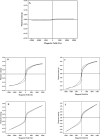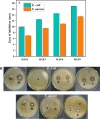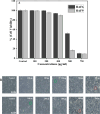Structural, morphological and biological assessment of magnetic hydroxyapatite with superior hyperthermia potential for orthopedic applications
- PMID: 39863634
- PMCID: PMC11762292
- DOI: 10.1038/s41598-025-87111-7
Structural, morphological and biological assessment of magnetic hydroxyapatite with superior hyperthermia potential for orthopedic applications
Abstract
Hydroxyapatite (HA) is an important constituent of natural bone. The properties of HA can be enhanced with the help of various ionic substitutions in the crystal lattice of HA. Iron (Fe) is a vital element present in bones and teeth. In this study, iron-doped HA was synthesized using a refluxing-based sol-gel route with varying concentrations of iron (1-9 M%). Samples were analyzed using an X-ray diffractometer (XRD), UV-Vis Spectrophotometer, Fourier-transform infrared spectroscopy (FT-IR), vibrating sample magnetometer (VSM) and Scanning Electron Microscope (SEM). The biological assessment was carried out by hemolytic assay, anti-bacterial activity and in-vitro biocompatibility. XRD data confirmed the evolution of the hexagonal HA crystal structure with the reduction in the crystallinity and the crystallite size. All the characteristic bands were confirmed using FT-IR which also further proved the existence of A-type carbonated apatite. The UV-Vis spectra confirmed the reduction in the band gap energies owing to the substitution of iron. The SEM results showed a change in the shape of the samples with increasing iron concentration. The magnetic behavior of samples also altered from diamagnetic to ferromagnetic behavior due to the doping of iron with enhanced heating efficiency. All the samples were found to be hemocompatible. The antibacterial efficacy was found to be higher for E. coli (gram-negative) bacteria compared to S. aureus (gram-positive) bacteria. Moreover, the superior cell viability of MG-63 (osteoblast-like) cells was observed in Fe-doped HA, attributed to MTT assay which revealed the enhanced cell viability of osteoblast-like cells in the Fe-doped HA. These results strongly emphasize the potential of the developed samples for bone regeneration applications.
Keywords: Anti-bacterial activity; Cytotoxicity; Hyperthermia; Iron-doped HA; Sol-gel.
© 2025. The Author(s).
Conflict of interest statement
Declarations. Competing interests: The authors declare no competing interests.
Figures










Similar articles
-
Balancing antibacterial activity and toxicity in silver-loaded hydroxyapatite: the impact of the silver nanoparticle incorporation method.J Mater Chem B. 2025 Aug 13;13(32):9954-9967. doi: 10.1039/d5tb01113b. J Mater Chem B. 2025. PMID: 40694031
-
Synthesis of eggshells-based hydroxyapatite/Acacia nilotica gum-based polymer composite for biomedical applications.Int J Biol Macromol. 2025 Jul;318(Pt 4):145267. doi: 10.1016/j.ijbiomac.2025.145267. Epub 2025 Jun 15. Int J Biol Macromol. 2025. PMID: 40527374
-
Microwave assisted starch stabilized green synthesis of zinc oxide nanoparticles for antibacterial and photocatalytic applications.Sci Rep. 2025 Aug 2;15(1):28288. doi: 10.1038/s41598-025-14193-8. Sci Rep. 2025. PMID: 40753352 Free PMC article.
-
Assessing the comparative effects of interventions in COPD: a tutorial on network meta-analysis for clinicians.Respir Res. 2024 Dec 21;25(1):438. doi: 10.1186/s12931-024-03056-x. Respir Res. 2024. PMID: 39709425 Free PMC article. Review.
-
Prevalence and odds of anxiety and depression in cutaneous malignant melanoma: a proportional meta-analysis and regression.Br J Dermatol. 2024 Jun 20;191(1):24-35. doi: 10.1093/bjd/ljae011. Br J Dermatol. 2024. PMID: 38197404
Cited by
-
Engineering Stepped Structures on Hydroxyapatite Surfaces: A Potential Strategy to Modulate Bone Marrow Mesenchymal Stem Adhesion, Spreading, and Proliferation.J Funct Biomater. 2025 May 8;16(5):165. doi: 10.3390/jfb16050165. J Funct Biomater. 2025. PMID: 40422830 Free PMC article.
References
-
- Ding, B. et al. A strong and tough hydroxyapatite-based fiber with enamel-inspired hierarchical structure. Sci. China Mater.67, 2496–2504 (2024).
Publication types
MeSH terms
Substances
LinkOut - more resources
Full Text Sources
Miscellaneous

